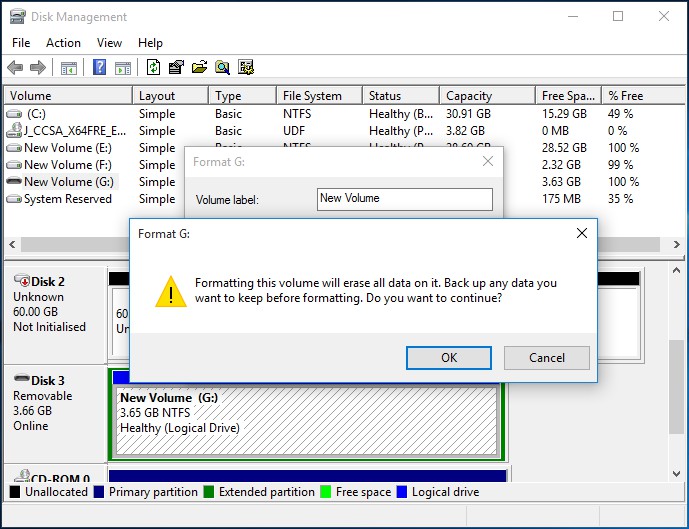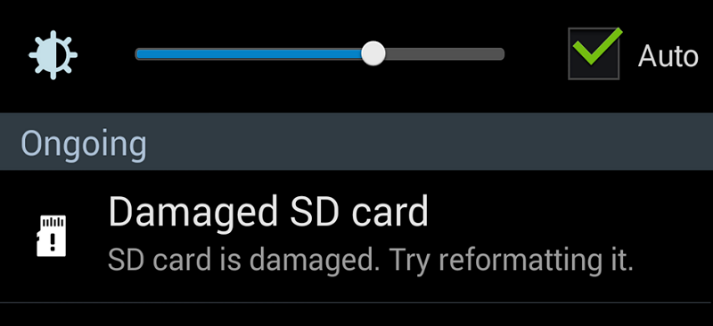

- #Sdcard formatter fail how to#
- #Sdcard formatter fail serial#
- #Sdcard formatter fail full#
- #Sdcard formatter fail verification#
- #Sdcard formatter fail iso#
Opened \\.\PHYSICALDRIVE2 for exclusive write access SetLGP: Successfully set NoDriveTypeAutorun policy to 0x0000009Eįound USB 2.0 device 'Generic- Compact Flash USB Device' (058F:6362)ĭevice eliminated because it appears to contain no mediaįound USB 2.0 device 'Generic- SD/MMC USB Device' (058F:6362)įound USB 2.0 device 'Generic- MS/MS-Pro USB Device' (058F:6362)įound USB 2.0 device 'Generic- SM/xD-Picture USB Device' (058F:6362)ĭisk type: Removable, Disk size: 32GB, Sector size: 512 bytesĬylinders: 3880, Tracks per cylinder: 255, Sectors per track: 63
#Sdcard formatter fail verification#
Issue 3: Verification Failed First, connect the SD card or USB drive with the.
#Sdcard formatter fail how to#
Windows version: Windows 10 64-bit (Build 15063) For instructions on how to format your USB drive using Chromebook Recovery. Error Error: Undertermined error while formatting. You can download SD Formatter 5.0.1 from the SD Card formatter website. Use SD Formatter The SD Association - the consortium which sets out the standards for SD cards - has its own formatting utility which. I formatted the card fully, overwritting with 0's and then tried formatting with Rufus, and the same error. If for some reason the card fails to format, there are couple of alternatives to try. Only with the official SD Card Formatter tool can I format the card. However, with Windows built in formatting tool, and Rufus, I am unable to complete a simple format of the USB. I pulled out the 32GB SD card from my Dash cam, because my Dash cam was weirding out. I confirmed, by performing an internet search, that these values match the ones from the official image.
#Sdcard formatter fail iso#
If using an ISO image, I clicked on the # button (at the bottom of the Rufus interface), to compute the MD5, SHA1 and SHA256 checksums, which are therefore present in the log I copied.I also tried one or more of the following: The continuous writing and overwriting of files puts a lot of stress onto the SD card, if a card has not been designed for this very specific use it is far more.I ran a bad blocks check, by clicking the "bad blocks" check box in Rufus, and confirmed that my USB is not defective.I've tried uninstalling and reinstalling multiple times.
#Sdcard formatter fail full#

* to 10 to disable the Ethernet controller. * For example, with the Ethernet shield, set DISABLE_CHIP_SELECT * Set DISABLE_CHIP_SELECT to disable a second SPI device. * Default SD chip select is the SPI SS pin. * Adafruit SD shields and modules, pin 10. * This program attempts to initialize an SD card and analyze its structure.
#Sdcard formatter fail serial#
This is the outcome (through the Serial monitor): SdFat version: 20160719Įdit DISABLE_CHIP_SELECT to disable another device.Įdit SD_CHIP_SELECT to change the SD chip select pin.ĬardSize: 32026.66 MB (MB = 1,000,000 bytes)įreeSpace: 32011.22 MB (MB = 1,000,000 bytes) It is strongly recommended to use the SD Memory Card Formatter to format SD/SDHC/SDXC. The SD Memory Card Formatter formats SD Memory Card, SDHC Memory Card and SDXC Memory Card (respectively SD/SDHC/SDXC Cards) complying with the SD File System Specification created by the SD Association (SDA). However, I started by testing out the SD card through the SdInfo class that comes as an example with the SdFat library. SD Memory Card Formatter 5.0.2 for SD/SDHC/SDXC. My final goal is to log information every 100 ms about the temperature and pressure of my device using another one of my sensors. I recently bought a micro SD storage shield for my arduino project, this is the link.


 0 kommentar(er)
0 kommentar(er)
